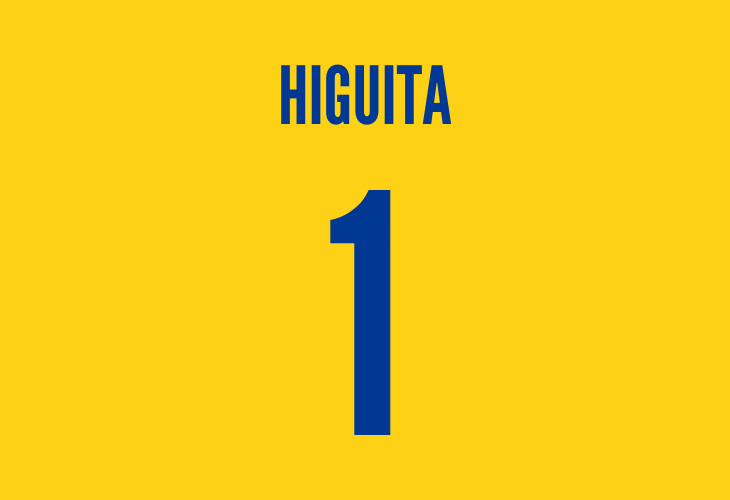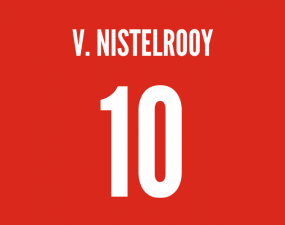Player Profile: Rene Higuita
Date of Birth: 27/08/1966
Height: 1.75 m (5 ft 9 in)
Position: Goalkeeper
National Team: Colombia
International Caps: 68
International Goals: 3
Club Career
South American goalkeepers are a different breed than the rest. Through the decades the world has marveled at the eccentricities of men like Paraguay’s Jose Luis Chilavert, Brazil’s Rogerio Ceni, and the original El Loco, Argentina’s Hugo Gatti. However, few can compare to the greatness and madness of Colombia’s Rene Higuita.
Higuita’s career began like most footballers, as a schoolboy. As a youngster though, he played up top as a striker. According to reports, he was a prolific scorer at youth level until one day his team’s goalkeeper was injured during a match. Higuita was given the gloves and the rest was history. That’s not to say he didn’t still find the back of the opponent’s net on occasion.
It’s that history as an outfield player that made Higuita the revolutionary player he would become. In many ways, he remained a field player who just happened to play goalie.
Higuita’s professional career began in his hometown of Medellin, with local club Millonarios, in 1985. He played just 16 matches yet managed to score 7 times. Higuita was particularly adept at penalties and free kicks. It was clear to everyone in Colombian football that Higuita was a star in the making.
Atletico Nacional, who was a cross-town rival of Millonarios and supported both emotionally and financially by cartel boss Pablo Escobar, took notice and bought him after just one professional season. Higuita would be a part of the greatest run Nacional would ever see, domestically and on the continent.
From 1986-1992 Higuita would mind the net, and more, for Nacional. He made 112 appearances and scored once. During this period Nacional would win the Colombian league, and become the first Colombian club to win the Copa Libertadores, the South American club championship.
During his club’s run in the 1989 Copa Libertadores, Higuita scored a crucial penalty shootout goal to send Nacional past Peruvian side Olimpia in the final. He also saved three penalties to secure the win.
Higuita’s play gained international attention when he appeared in the 1990 World Cup with Colombia. His revolutionary “sweeper-keeper” style caught the attention of European scouts and would lead to a brief move to Spain.
See Higuita wasn’t like ordinary keepers who patrolled their 18-yard box and waited for the action to come to them. No, Higuita’s territory was anywhere inside his own half of the field. Instead of waiting for the game to come to him, he went to the game.
The skills he developed as a striker came in handy as he was very competent with the ball at his feet. More important than his foot skills though was his mentality. While most keepers would boot the ball as far as the could to get it away from their goal, Higuita was calm and poised in possession.
He was a revolutionary.
Some claim that the Dutch keeper, Jan Jongbloed, was the first “sweeper-keeper” but he came out of the 18-yard box to smash the ball out of play. Higuita came out to restart the attack.
The back-pass law came into effect in 1992, and was passed as a direct rebuttal to Higuita’s play, and is sometimes referred to as the “Higuita Law.”
Spanish club Real Valladolid thought they needed some of that in their club. Valladolid poached Higuita and Colombia teammates Carlos Valderrama, and Leonel Alvarez. They even brought over Colombia’s coach, Francisco Maturana, to manage the club.
The experiment failed and by the end of the 1992 season, all four men were back in Colombia. Higuita played 14 times for the club and gave up 23 goals while in Spain.
Next, Higuita returned to Atletico Nacional where he would spend 5 seasons, winning the league yet again. He left Nacional for good after the 1997 season, having played 181 times for the club.
1997 began a whirlwind 12 years for Higuita where he became a mercenary goalkeeper, playing for 9 clubs across Colombia, Mexico, Venezuela, and Ecuador.
Higuita scored 41 goals in his club career, and most of them came during this stretch of his career where he was signed by clubs as much for his reputation and fame as for his playing abilities. As such, clubs were willing to allow him to take penalties and free kicks for the novel entertainment value of it. It should be added, Higuita was a skilled taker of both.
During the 1999-2000 season alone, Higuita scored 11 times for Independiente Medellin in just 20 games.
He ranks 5th all-time in world soccer for most goals scored by a goalkeeper, with 41.
Higuita’s career faced some controversy in 2004 while playing with Ecuadorian side Aucas when he tested positive for cocaine. He checked into rehab and wasn’t seen on a football pitch again until 2007.
Higuita retired in 2009 after having played a total of 380 matches across 25 years.
Those who don’t know the career of Rene Higuita remember him for one thing, the famous scorpion kick at Wembley against England. But Higuita’s legacy goes far beyond that.
For the first time, a goalkeeper was more than just a shot-stopper. Higuita revolutionized the position. As Colombia coach Francisco Maturana said ahead of the 1990 World Cup, With Rene as sweeper, we have 11 outfield players.”
It earned him the nickname “El Loco”, or The Madman, but in truth, he was just ahead of his time.
We are currently living in the golden age of the sweeper-keeper. Many incorrectly credit German Manuel Neuer with that, and while his play is responsible for the proliferation of sweeper-keepers through the world today, there would be no Neuer, Alisson, or Ederson without Higuita.
That should be his true legacy.
International Career
Colombia’s “Golden Generation” of the late ‘80s and early ‘90s was led by two men, Carlos Valderrama and Rene Higuita.
Valderrama paced the team from midfield and added style and grace that Los Cafeteros had never seen before, but Rene Higuita’s eccentric sweeper-keeper style at the back gave the team its soul.
Like Higuita’s play, when things were going well it was a sight to behold. Led by Higuita and Valderrama, Colombia made its mark on South America. They challenged continental powerhouses Brazil and Argentina at Copa America tournaments, finishing a historic 3rd 3 times during their time.
However, there were consequences to the way Higuita and Colombia played. Colombia was eliminated from the 1990 World Cup on a goal allowed by Higuita when he tried to intercept a pass at midfield to start a counter-attack. Instead, Cameroon’s Roger Milla won the ball, dribbled down the field and scored.
A more tragic example of this is the 1994 World Cup. Colombia fell apart at the first sign of trouble, while he was back home in Colombia watching from his couch. Because of his friendship with drug kingpin Pablo Escobar, Higuita was arrested in connection with a kidnapping scheme.
In 1993, Higuita allegedly acted as a go-between for Escobar and fellow drug baron Carlos Molina. He was responsible for delivering the ransom money from Molina to Escobar, who had kidnapped Molina’s daughter. He spent seven months in jail before being released without being charged. Because of his lengthy prison stay, Higuita was in no shape to perform at the World Cup.
While it’s unlikely that Higuita’s presence in the squad could have changed what was a World Cup campaign doomed from the start by outside influences, he missed what should have been the biggest moment of his career because of the risky decisions he made.
In 1995, Higuita put on one of the more memorable performances in goalkeeping history. In a friendly against England, he created a bit of magic that he is most commonly remembered for today, the scorpion kick. It was a move he claims to have tried in practice over the years but never attempted in a match.
With a long shot from England’s Jamie Redknapp floating his way, Higuita launched himself in the air, flung his legs up behind him, and kicked the ball to safety with the bottom of his feet.
Higuita received his 68th and final international cap in 1999. During his 13 years with the national team, he scored 3 goals, played in one World Cup, and helped Colombia to their highest ever finish, until that point, in 3 separate Copa America’s.
Rene Higuita retired from national team duty in 1999, having appeared 68 times for his country, scoring 3 goals.
Where is Rene Higuita Now?
Rene Higuita has lived his life outside of football similarly to how he lived in on the pitch. Since retiring in 2009, he has been a busy man. He featured on a reality television show in the style of Survivor, and he had his extensive plastic surgery work filmed for a reality show called Extreme Change.
He’s even tried his hand at coaching. From 2012-2016 he was the goalkeeper’s coach for the UAE club Al-Nasr. These days he’s returned to Atletico Nacional and has served as their goalkeeping coach since 2017.
Did You Know?
– Higuita has been ranked by the IFFHS as the 8th best South American goalkeeper in history.
– England’s Channel 4 ranked Higuita’s “Scorpion Kick” as the 94th of their 100 Greatest Sporting Moments.
– He grew up poor and was raised by his grandmother after his mother died when he was young. He worked as a paperboy, among other jobs, to help support his family.
– Higuita unsuccessfully ran for mayor of Guarne, a Medellin suburb, in 2011.




